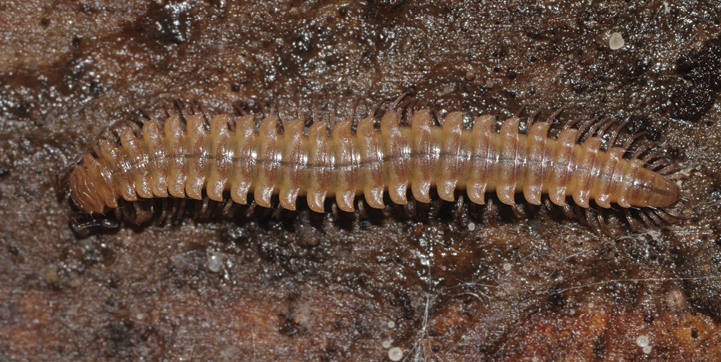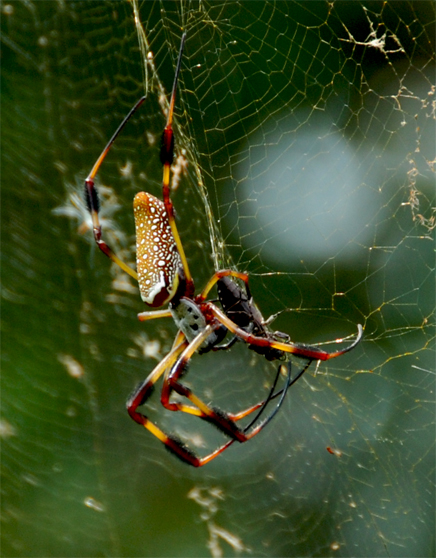|
Neocambrisoma
''Neocambrisoma'' is a genus of millipedes in the Family (biology), family Metopidiotrichidae. Millipedes in this genus are found in Tasmania and New South Wales in Australia. Like other genera in this family, this genus features 32 segments (counting the collum as the first segment and the telson as the last) in adults of both sexes, rather than the 30 segments usually observed in adults in the order Chordeumatida. Accordingly, female adults in this genus have 54 pairs of legs, which is not only the maximum number observed in this order but also the maximum number fixed by species in the class Millipede, Diplopoda. Discovery The genus ''Neocambrisoma'' was first described in 1987 by the French Myriapodology, myriapodologist species:Jean-Paul_Mauriès, Jean-Paul Mauriès of the National Museum of Natural History, France, Muséum National d’Histoire Naturelle in Paris to contain the newly discovered type species ''Neocambrisoma raveni, N. raveni''. He based the original descrip ... [...More Info...] [...Related Items...] OR: [Wikipedia] [Google] [Baidu] |
Neocambrisoma Cachinnus
''Neocambrisoma'' is a genus of millipedes in the family Metopidiotrichidae. Millipedes in this genus are found in Tasmania and New South Wales in Australia. Like other genera in this family, this genus features 32 segments (counting the collum as the first segment and the telson as the last) in adults of both sexes, rather than the 30 segments usually observed in adults in the order Chordeumatida. Accordingly, female adults in this genus have 54 pairs of legs, which is not only the maximum number observed in this order but also the maximum number fixed by species in the class Diplopoda. Discovery The genus ''Neocambrisoma'' was first described in 1987 by the French myriapodologist Jean-Paul Mauriès of the Muséum National d’Histoire Naturelle in Paris to contain the newly discovered type species '' N. raveni''. He based the original description of this genus and this species on a male holotype and 16 paratypes (6 males and 10 females) found in Bruxner Forest Park, near Coffs ... [...More Info...] [...Related Items...] OR: [Wikipedia] [Google] [Baidu] |
Neocambrisoma Raveni
''Neocambrisoma raveni'' is a species of millipede in the family Metopidiotrichidae. These millipedes are found in New South Wales in Australia. Like other species in this family, ''N. raveni'' features 32 segments (counting the collum as the first segment and the telson as the last) in adults of both sexes, rather than the 30 segments usually observed in adults in the order Chordeumatida. Accordingly, adult females of this species have 54 pairs of legs, which is not only the maximum number observed in this order but also the maximum number fixed by species in the class Diplopoda. Discovery This species was first described in 1987 by the French myriapodologist Jean-Paul Mauriès of the Muséum National d’Histoire Naturelle in Paris as the type species for the new genus ''Neocambrisoma''. He based the original description of this genus and this species on a male holotype and 16 paratypes (6 males and 10 females) found in Bruxner Forest Park, near Coffs Harbour in New South Wale ... [...More Info...] [...Related Items...] OR: [Wikipedia] [Google] [Baidu] |
Metopidiotrichidae
Metopidiotrichidae is a family of millipedes in the order Chordeumatida. These millipedes range from 4 mm to 17 mm in length. Adult millipedes in this family have 32 segments (counting the collum as the first segment and the telson as the last), not the 30 segments usually found in this order. Adult males in this family (e.g., ''Reginaterreuma monroei'', ''R. daviesae'', ''R. unicolor'', ''R. major'', and ''Neocambrisoma raveni'') often feature a reduced or vestigial leg pair 10 as part of the gonopod complex, in addition to the two leg pairs (pairs 8 and 9) typically modified into gonopods in this order. There are about 9 genera and at least 70 described species in Metopidiotrichidae. Genera These nine genera belong to the family Metopidiotrichidae: * ''Australeuma'' Golovatch, 1986 * ''Malayothrix'' Verhoeff, 1929 * ''Metopidiothrix'' Attems, 1907 * ''Neocambrisoma'' Mauriès, 1987 * ''Nesiothrix'' Shear & Mesibov, 1997 * ''Nipponothrix'' Shear & Tanabe, 1994 * ''Pocockia (milli ... [...More Info...] [...Related Items...] OR: [Wikipedia] [Google] [Baidu] |
Chordeumatida
Chordeumatida (from the Greek word for "sausage") is a large order of millipedes containing some 1200 species with a nearly worldwide distribution. Also known as "sausage millipedes," they possess around 30 body segments behind the head (including the telson) as adults and reach about in length. Description Chordeumatidans are relatively short-bodied, with only 26 to 32 body segments (including the telson) behind the head. They range in length from . A key feature is the presence of 6 large bristles (setae) on the dorsal surface of each body segment. The first segment ( collum) is relatively narrow, giving the appearance of a distinct "neck" in many species. The body tapers towards the rear, and the rearmost tip (telson) contains silk-producing organs (spinnerets). A dorsal groove runs down the length of the body, and some species possess paranota, lateral extensions of the exoskeleton. Paranota are also found in some other millipedes, notably Polydesmida, from which Chordeumat ... [...More Info...] [...Related Items...] OR: [Wikipedia] [Google] [Baidu] |
Zoology
Zoology ()The pronunciation of zoology as is usually regarded as nonstandard, though it is not uncommon. is the branch of biology that studies the animal kingdom, including the structure, embryology, evolution, classification, habits, and distribution of all animals, both living and extinct, and how they interact with their ecosystems. The term is derived from Ancient Greek , ('animal'), and , ('knowledge', 'study'). Although humans have always been interested in the natural history of the animals they saw around them, and made use of this knowledge to domesticate certain species, the formal study of zoology can be said to have originated with Aristotle. He viewed animals as living organisms, studied their structure and development, and considered their adaptations to their surroundings and the function of their parts. The Greek physician Galen studied human anatomy and was one of the greatest surgeons of the ancient world, but after the fall of the Western Roman Empire ... [...More Info...] [...Related Items...] OR: [Wikipedia] [Google] [Baidu] |
Arachnology
Arachnology is the scientific study of arachnids, which comprise spiders and related invertebrates such as scorpions, pseudoscorpions, and harvestmen. Those who study spiders and other arachnids are arachnologists. More narrowly, the study of spiders alone (order Araneae) is known as araneology. The word " arachnology" derives from Greek , ''arachnē'', "spider"; and , ''-logia'', "the study of a particular subject". Arachnology as a science Arachnologists are primarily responsible for classifying arachnids and studying aspects of their biology. In the popular imagination, they are sometimes referred to as spider experts. Disciplines within arachnology include naming species and determining their evolutionary relationships to one another (taxonomy and systematics), studying how they interact with other members of their species and/or their environment ( behavioural ecology), or how they are distributed in different regions and habitats (faunistics). Other arachnologists perf ... [...More Info...] [...Related Items...] OR: [Wikipedia] [Google] [Baidu] |
Robert Raven
Robert John Raven is an Australian arachnologist, being the Head of Terrestrial Biodiversity and the Senior Curator (Arachnida) at the Queensland Museum. Dr Raven has described many species of spider in Australia and elsewhere, and is spider bite consultant to the Royal Brisbane Hospital The Royal Brisbane and Women's Hospital (RBWH) is a tertiary public hospital located in Herston, a suburb of Brisbane, Queensland, Australia. It is operated by Metro North Health, part of the Queensland Health network. The hospital has 929 bed ..., leading to much work on spider toxins. References External links Dr Robert Ravenat Queensland Museum Arachnids researchat Queensland Museum Australian arachnologists Living people Year of birth missing (living people) {{zoologist-stub ... [...More Info...] [...Related Items...] OR: [Wikipedia] [Google] [Baidu] |
Type (biology)
In biology, a type is a particular wiktionary:en:specimen, specimen (or in some cases a group of specimens) of an organism to which the scientific name of that organism is formally attached. In other words, a type is an example that serves to anchor or centralizes the defining features of that particular taxon. In older usage (pre-1900 in botany), a type was a taxon rather than a specimen. A taxon is a scientifically named grouping of organisms with other like organisms, a set (mathematics), set that includes some organisms and excludes others, based on a detailed published description (for example a species description) and on the provision of type material, which is usually available to scientists for examination in a major museum research collection, or similar institution. Type specimen According to a precise set of rules laid down in the International Code of Zoological Nomenclature (ICZN) and the International Code of Nomenclature for algae, fungi, and plants (ICN), the ... [...More Info...] [...Related Items...] OR: [Wikipedia] [Google] [Baidu] |
Genus
Genus ( plural genera ) is a taxonomic rank used in the biological classification of living and fossil organisms as well as viruses. In the hierarchy of biological classification, genus comes above species and below family. In binomial nomenclature, the genus name forms the first part of the binomial species name for each species within the genus. :E.g. '' Panthera leo'' (lion) and '' Panthera onca'' (jaguar) are two species within the genus ''Panthera''. ''Panthera'' is a genus within the family Felidae. The composition of a genus is determined by taxonomists. The standards for genus classification are not strictly codified, so different authorities often produce different classifications for genera. There are some general practices used, however, including the idea that a newly defined genus should fulfill these three criteria to be descriptively useful: # monophyly – all descendants of an ancestral taxon are grouped together (i.e. phylogenetic analysis should c ... [...More Info...] [...Related Items...] OR: [Wikipedia] [Google] [Baidu] |
William Shear
William Albert Shear (born 1942) is Trinkle Professor Emeritus at Hampden-Sydney College, Virginia. He is a spider and myriapod expert who has published more than 200 scientific articles primarily on harvestman and millipede taxonomy. He was born in Coudersport, Pennsylvania, completed his undergraduate work at College of Wooster, masters at the University of New Mexico, and PhD at the Museum of Comparative Zoology at Harvard University under the supervision of Herbert Walter Levi. While at Harvard, Shear completed a revision of the millipede family Cleidogonidae and reclassification of the order Chordeumatida. He is an expert in Paleozoic arthropods, and has published several papers on fossil millipedes, centipedes, and spiders. A number of species are named after him, including ''Hypochilus sheari'' Platnick, 1987 and ''Brachoria sheari'' Marek, 2010. Shear is a lifetime appointee as Senior Scientific Associate at the Virginia Museum of Natural History and is a research associ ... [...More Info...] [...Related Items...] OR: [Wikipedia] [Google] [Baidu] |
Robert Mesibov
Robert 'Bob' Evan Mesibov (born 9 March 1946) is an American born and educated Australian myriapod specialist. He earned a B.A. from New York University in 1966 and a Ph.D. in biochemistry from the University of Wisconsin–Madison in 1971. He migrated to Australia in 1973, settling in Tasmania where he became a curatorial assistant at the Queen Victoria Museum and Art Gallery in Launceston. He became an Australian citizen in 1976. Work His earliest publications were in the field of chemotaxis Chemotaxis (from '' chemo-'' + ''taxis'') is the movement of an organism or entity in response to a chemical stimulus. Somatic cells, bacteria, and other single-cell or multicellular organisms direct their movements according to certain chemica ..., but in 1990–1991, while working as a forest ecology and zoology consultant, he published his first zoological papers, on velvet worms in the family Peripatopsidae). In later life he has become increasingly concerned with problem ... [...More Info...] [...Related Items...] OR: [Wikipedia] [Google] [Baidu] |



.jpg)
